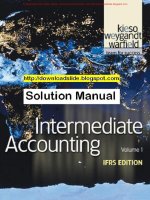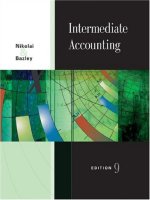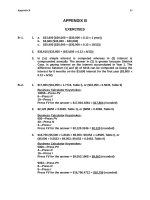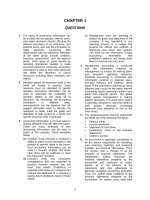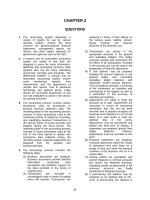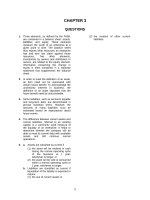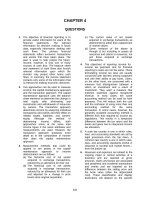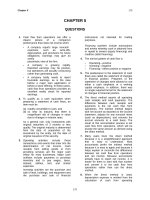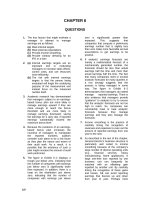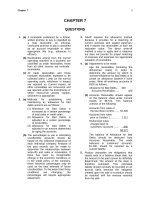Solution manual intermediate accounting 7th by nelson spiceland ch10
Bạn đang xem bản rút gọn của tài liệu. Xem và tải ngay bản đầy đủ của tài liệu tại đây (563.4 KB, 63 trang )
Find more slides, ebooks, solution manual and testbank on www.downloadslide.com
Chapter 10
Operational Assets: Acquisition and Disposition
QUESTIONS FOR REVIEW OF KEY TOPICS
Question 10-1
The term operational asset is used to describe the broad category of long-lived assets that are
used in the production of goods and services. The difference between tangible and intangible assets
is that intangible assets lack physical substance and they primarily refer to the ownership of rights.
Question 10-2
The cost of an operational asset includes the purchase price (less any discounts received from
the seller), transportation costs paid by the buyer to transport the asset to the location in which it will
be used, expenditures for installation, testing, legal fees to establish title, and any other costs of
bringing the asset to its condition and location for use.
Question 10-3
The cost of a developed natural resource includes the acquisition costs for the use of land, the
exploration and development costs incurred before production begins, and the restoration costs
incurred during or at the end of extraction.
Question 10-4
Purchased intangibles are valued at their original cost to include the purchase price and all
other necessary costs to bring the asset to condition and location for use. Research and development
costs incurred to internally develop an intangible asset are expensed in the period incurred. Filing
and legal costs for both purchased and developed intangibles are capitalized.
Question 10-5
Goodwill represents the unique value of the company as a whole over and above all
identifiable tangible and intangible assets. This value results from a company’s clientele and
reputation, its trained employees and management team, its unique business location, and any other
unique features of the company that can’t be associated with a specific asset.
Because goodwill can’t be separated from a company, it is not possible for a buyer to acquire it
without also acquiring the whole company or a substantial portion of it. Goodwill will appear as an
asset in a balance sheet only when it was paid for in connection with the acquisition of another
company. The capitalized cost of goodwill equals the purchase price of the acquired company less
the market value of the net assets acquired. The market value of the net assets equals the market
value of all identifiable tangible and intangible assets less the market value of any liabilities of the
selling company assumed by the buyer.
Solutions Manual, Vol.1, Chapter 10
© The McGraw-Hill Companies, Inc., 2007
10-1
Find more slides, ebooks, solution manual and testbank on www.downloadslide.com
Answers to Questions (continued)
Question 10-6
A lump-sum purchase price generally is allocated based on the relative market values of the
individual assets. The relative market value percentages are multiplied by the lump-sum purchase
price to arrive at the initial valuation of each of the separate assets.
Question 10-7
Assets acquired in exchange for deferred payment contracts are valued at their fair value or the
present value of payments using a realistic interest rate. Theoretically, both alternatives should lead
to the same valuation.
Question 10-8
Assets acquired through the issuance of equity securities are valued at the fair value of the
securities if known; if not known, the fair value of the assets received is used.
Question 10-9
Donated assets are valued at their fair values.
Question 10-10
When an operational asset is sold, a gain or loss is recognized for the difference between the
consideration received and the asset’s book value. Retirements and abandonments are handled in a
similar fashion. The only difference is that there will be no monetary consideration received. A loss
is recorded for the remaining book value of the asset.
Question 10-11
The basic principle used to value assets acquired in a nonmonetary exchange is to use the fair
value of asset(s) given up plus (minus) monetary consideration - cash - paid (received).
Question 10-12
The two exceptions are (1) when fair value is not determinable, and (2) when the exchange
lacks commercial substance.
Question 10-13
GAAP require the capitalization of interest incurred during the construction of assets for a
company’s own use as well as for assets constructed for sale or lease. Assets qualifying for
capitalization exclude inventories that are routinely manufactured in large quantities on a repetitive
basis and assets that are in use or ready for their intended purpose. Only assets that are constructed
as discrete projects qualify for interest capitalization.
© The McGraw-Hill Companies, Inc., 2007
10-2
Intermediate Accounting, 4/e
Find more slides, ebooks, solution manual and testbank on www.downloadslide.com
Answers to Questions (continued)
Question 10-14
Average accumulated expenditures for a period is an approximation of the average amount of
debt the company would have had outstanding if it borrowed all of the funds necessary for
construction. If construction expenditures are incurred equally throughout the period, the average
accumulated expenditures for the period can be estimated by adding the accumulated expenditures at
the beginning of the period to the accumulated expenditures at the end of the period and dividing by
two. If expenditures on the project are unequal throughout the period, individual expenditures,
perhaps expenditures grouped by month, should be weighted by the amount of time outstanding until
the end of the construction period or the end of the company’s fiscal year, whichever comes first.
Question 10-15
Applying the specific interest method, the interest rate on any construction related debt is used
up to the amount of the construction debt and any excess average accumulated expenditures is
multiplied by a weighted-average interest rate of all other debt. The weighted-average method
multiplies average accumulated expenditures by the weighted-average interest rate of all debt,
including any construction-related debt.
Question 10-16
SFAS 2 defines research and development as follows:
Research is planned search or critical investigation aimed at discovery of new knowledge with
the hope that such knowledge will be useful in developing a new product or service or a new process
or technique or in bringing about a significant improvement to an existing product or process.
Development is the translation of research findings or other knowledge into a plan or design for
a new product or process or for a significant improvement to an existing product or process whether
intended for sale or use.
Question 10-17
SFAS 2 specifically excludes from current R&D expense the cost of operational assets that
have “alternative future uses” beyond the current R&D project. However, the depreciation or
amortization of these assets will be included as R&D expenses in the future periods the assets are
used for R&D activities. If the equipment has no alternative future use, its cost is expensed as R&D
immediately.
Question 10-18
GAAP require the capitalization of software development costs incurred after technological
feasibility is established. Technological feasibility is established “when the enterprise has completed
all planning, designing, coding, and testing activities that are necessary to establish that the product
can be produced to meet its design specifications including functions, features, and technical
performance requirements.” Costs incurred after technological feasibility but before the product is
available for general release to customers are capitalized as an intangible asset. These costs include
coding and testing costs and the production of product masters. Similar to SFAS 2, costs incurred
after commercial production begins usually are not R&D expenditures.
Solutions Manual, Vol.1, Chapter 10
© The McGraw-Hill Companies, Inc., 2007
10-3
Find more slides, ebooks, solution manual and testbank on www.downloadslide.com
Answers to Questions (concluded)
Question 10-19
The cost of developed technology is capitalized and expensed over its expected useful life.
The cost of in-process R&D is expensed in the period of the acquisition. Developed technology
relates to those projects that have reached technological feasibility.
Question 10-20
The successful efforts method allows companies to capitalize only exploration costs resulting
in successful wells. The full-cost method allows companies to capitalize all exploration costs
incurred within a geographical area.
© The McGraw-Hill Companies, Inc., 2007
10-4
Intermediate Accounting, 4/e
Find more slides, ebooks, solution manual and testbank on www.downloadslide.com
BRIEF EXERCISES
Brief Exercise 10-1
Capitalized cost of the machine:
Purchase price
Freight
Installation
Testing
Total cost
$35,000
1,500
3,000
2,000
$41,500
Note: Personal property taxes on the machine for the period after acquisition are
not part of acquisition cost. They are expensed in the period incurred.
Brief Exercise 10-2
Capitalized cost of land:
Purchase price
Broker’s commission
Title insurance
Miscellaneous closing costs
Demolition of old building
Total cost
$600,000
30,000
3,000
6,000
18,000
$657,000
All of the expenditures, including the costs to demolish the old building, are
included in the initial cost of the land.
Solutions Manual, Vol.1, Chapter 10
© The McGraw-Hill Companies, Inc., 2007
10-5
Find more slides, ebooks, solution manual and testbank on www.downloadslide.com
Brief Exercise 10-3
Cost of land and building:
Purchase price
Broker’s commission
Title insurance
Miscellaneous closing costs
Total cost
$600,000
30,000
3,000
6,000
$639,000
The total must be allocated to the land and building based on their relative market
values:
Percent of Total
Market Value
Asset
Land
Building
Market Value
$420,000
280,000
$700,000
60%
40
100%
Initial
Valuation
(Percent x
$639,000)
$383,400
255,600
$639,000
Brief Exercise 10-4
Cost of silver mine:
Acquisition, exploration, and development
Restoration costs
†
$5,600,000
429,675 †
$6,029,675
$500,000 x 20% = $100,000
550,000 x 45% = 247,500
650,000 x 35% = 227,500
$575,000 x .74726* = $429,675
*Present value of $1, n = 5, i = 6% (from Table 2)
© The McGraw-Hill Companies, Inc., 2007
10-6
Intermediate Accounting, 4/e
Find more slides, ebooks, solution manual and testbank on www.downloadslide.com
Brief Exercise 10-5
After one year, the liability will increase to $455,456.
($429,675† + ($429,675 x 6%) = $455,456)
†
$500,000 x 20% = $100,000
550,000 x 45% = 247,500
650,000 x 35% = 227,500
$575,000 x .74726* = $429,675
*Present value of $1, n = 5, i = 6% (from Table 2)
Actual restoration costs
Less: Asset retirement liability
Loss on retirement
$596,000
(575,000)
$ (21,000)
Brief Exercise 10-6
Calculation of goodwill:
Purchase price
Less fair value of net assets:
Book value of assets
Plus: Excess of fair value over book value
of intangible assets
Goodwill
Solutions Manual, Vol.1, Chapter 10
$14,000,000
$8,300,000
2,500,000
(10,800,000)
$ 3,200,000
© The McGraw-Hill Companies, Inc., 2007
10-7
Find more slides, ebooks, solution manual and testbank on www.downloadslide.com
Brief Exercise 10-7
The initial value of machinery and note will be the present value of the note
payment:
PV = $60,000 (.85734* ) = $51,440
* Present value of $1: n = 2, i = 8% (from Table 2)
Interest expense for 2006:
$51,440 x 8% x 6/12 = $2,058
Brief Exercise 10-8
The cost of the patent equals the market value of the stock given in exchange:
50,000 x $22 = $1,100,000
Brief Exercise 10-9
Average PP&E for 2006 = ($740,000 + 940,000) ÷ 2 = $840,000
Net sales ÷ Average PP&E = Fixed-asset turnover ratio
?
÷ $840,000
=
3.25
Average PP&E x Fixed-asset turnover ratio = Net sales
$840,000
x
3.25
= $2,730,000
© The McGraw-Hill Companies, Inc., 2007
10-8
Intermediate Accounting, 4/e
Find more slides, ebooks, solution manual and testbank on www.downloadslide.com
Brief Exercise 10-10
Proceeds
Less book value:
Gain on sale of equipment
$16,000
$80,000
(71,000)
9,000
$ 7,000
Journal entry (not required):
Cash ..............................................................................
Accumulated depreciation (account balance) ....................
Gain (difference) ..........................................................
Equipment (account balance) .........................................
16,000
71,000
7,000
80,000
Brief Exercise 10-11
Pickup trucks = Fair value of machinery less cash received
$17,000 – 8,000 = $9,000
Loss on exchange = $20,000 (book value) – 17,000 (fair value) = $3,000
Journal entry (not required):
Cash ..............................................................................
Pickup trucks (determined above) .....................................
Accumulated depreciation (account balance) ....................
Loss (difference) ..............................................................
Machinery (account balance) .........................................
Solutions Manual, Vol.1, Chapter 10
8,000
9,000
45,000
3,000
65,000
© The McGraw-Hill Companies, Inc., 2007
10-9
Find more slides, ebooks, solution manual and testbank on www.downloadslide.com
Brief Exercise 10-12
Pickup trucks = Fair value of machinery less cash received
$24,000 – 8,000 = $16,000
Gain on exchange = $24,000 (fair value) – 20,000 (book value ) = $4,000
Journal entry (not required):
Cash ..............................................................................
Pickup trucks (determined above) .....................................
Accumulated depreciation (account balance) ....................
Gain (difference) ..........................................................
Machinery (account balance) .........................................
8,000
16,000
45,000
4,000
65,000
Brief Exercise 10-13
Pickup trucks = Book value of machinery less cash received
$20,000 – 8,000 = $12,000
No gain is recognized in this situation.
Journal entry (not required):
Cash ..............................................................................
Pickup trucks (determined above) .....................................
Accumulated depreciation (account balance) ....................
Machinery (account balance) .........................................
© The McGraw-Hill Companies, Inc., 2007
10-10
8,000
12,000
45,000
65,000
Intermediate Accounting, 4/e
Find more slides, ebooks, solution manual and testbank on www.downloadslide.com
Brief Exercise 10-14
Average accumulated expenditures:
January 2, 2006
March 31, 2006
June 30, 2006
$500,000 x
600,000 x
400,000 x
600,000 x
October 30, 2006
12/12
9/12
6/12
2/12
= $ 500,000
=
=
=
450,000
200,000
100,000
$1,250,000
Interest capitalized:
$1,250,000
- 700,000
$ 550,000
x 7% = $49,000
x 6.75%* = 37,125
$ 86,125 = interest capitalized
* Weighted-average rate of all other debt:
$3,000,000
5,000,000
$8,000,000
x
8% = $240,000
x
6% =
300,000
$540,000
$540,000
= 6.75% weighted average
$8,000,000
Solutions Manual, Vol.1, Chapter 10
© The McGraw-Hill Companies, Inc., 2007
10-11
Find more slides, ebooks, solution manual and testbank on www.downloadslide.com
Brief Exercise 10-15
Average accumulated expenditures:
January 2, 2006
March 31, 2006
June 30, 2006
$500,000 x
600,000 x
400,000 x
600,000 x
October 30, 2006
12/12
9/12
6/12
2/12
= $ 500,000
=
=
=
450,000
200,000
100,000
$1,250,000
Interest capitalized:
$1,250,000
x
6.77%* = $84,625
* Weighted-average rate of all other debt:
$ 700,000
3,000,000
5,000,000
$8,700,000
x
7% = $ 49,000
x
8% =
240,000
x
6% =
300,000
$589,000
$589,000
= 6.77% weighted average
$8,700,000
Brief Exercise 10-16
Research and development:
Salaries
Depreciation on R & D facilities and equipment
Utilities and other direct costs
Payment to another company
Total R & D expense
© The McGraw-Hill Companies, Inc., 2007
10-12
$220,000
125,000
66,000
120,000
$531,000
Intermediate Accounting, 4/e
Find more slides, ebooks, solution manual and testbank on www.downloadslide.com
Note: The patent filing and related legal costs and the costs of adapting the
product to a particular customer’s needs are not included as research and development
expense.
Solutions Manual, Vol.1, Chapter 10
© The McGraw-Hill Companies, Inc., 2007
10-13
Find more slides, ebooks, solution manual and testbank on www.downloadslide.com
EXERCISES
Exercise 10-1
Capitalized cost of land:
Purchase price
Demolition of old building
Less: Sale of materials
Legal fees for title investigation
Total cost of land
$60,000
$4,000
(2,000)
2,000
2,000
$64,000
Capitalized cost of building:
Construction costs
Architect's fees
Interest on construction loan
Total cost of building
$500,000
12,000
5,000
$517,000
Note: Property taxes on the land for the period after acquisition are not part of
acquisition cost. They are expensed in the period incurred.
Exercise 10-2
To record the purchase of a machine.
Machine ($45,000 + + 2,200 + 700 + 1,000) .........................
Accounts payable ......................................................
Cash ..........................................................................
48,900
47,200
1,700
To record prepaid insurance for the machine.
Prepaid insurance ..........................................................
Cash ..........................................................................
© The McGraw-Hill Companies, Inc., 2007
10-14
900
900
Intermediate Accounting, 4/e
Find more slides, ebooks, solution manual and testbank on www.downloadslide.com
Exercise 10-3
Requirement 1
Cost of copper mine:
Mining site
Development costs
Restoration costs
†
$300,000 x 25% =
400,000 x 40% =
600,000 x 35% =
$1,000,000
600,000
303,939 †
$1,903,939
$ 75,000
160,000
210,000
$445,000 x .68301* = $303,939
*Present value of $1, n = 4, i = 10%
Requirement 2
Copper mine (determined above) .................................... 1,903,939
Cash ($1,000,000 + 600,000).......................................
1,600,000
Asset retirement liability (determined above) ............
303,939
Equipment (cost) .........................................................
Cash .......................................................................
Solutions Manual, Vol.1, Chapter 10
120,000
120,000
© The McGraw-Hill Companies, Inc., 2007
10-15
Find more slides, ebooks, solution manual and testbank on www.downloadslide.com
Exercise 10-4
Organization cost expense ($12,000 + 3,000) ....................
Patent ($20,000 + 2,000) ...................................................
Pre-opening expenses ...................................................
Furniture .......................................................................
Cash ..........................................................................
15,000
22,000
40,000
30,000
107,000
Exercise 10-5
Calculation of goodwill:
Purchase price
Less fair value of net assets:
Assets
Less: Liabilities assumed
Goodwill
$17,000,000
$23,000,000
(9,500,000)
(13,500,000)
$ 3,500,000
Exercise 10-6
Calculation of goodwill:
Purchase price
Less fair value of net assets:
Book value of net assets
Plus: Fair value in excess of book value:
Property, plant, and equipment
Intangible assets
Less: Book value in excess of fair value:
Receivables
Goodwill
© The McGraw-Hill Companies, Inc., 2007
10-16
$11,000,000
$7,800,000
1,400,000
1,000,000
(200,000)
10,000,000
$ 1,000,000
Intermediate Accounting, 4/e
Find more slides, ebooks, solution manual and testbank on www.downloadslide.com
Exercise 10-7
1.
2.
3.
a
d
c
Exercise 10-8
Percent of Total
Market Value
Asset
Land ................
Building A .......
Building B .......
Solutions Manual, Vol.1, Chapter 10
Market Value
$ 300,000
450,000
250,000
$1,000,000
30%
45
25
100%
Initial
Valuation
(Percent x
$900,000)
$270,000
405,000
225,000
$900,000
© The McGraw-Hill Companies, Inc., 2007
10-17
Find more slides, ebooks, solution manual and testbank on www.downloadslide.com
Exercise 10-9
Requirement 1
Tractor ($5,000 cash + 18,783† present value of note) .............
Discount on note payable (difference) .............................
Cash ..........................................................................
Note payable (face amount) ..........................................
†
23,783
6,217
5,000
25,000
Present value of note payment:
PV = $25,000 (.75131* ) = $18,783
* Present value of $1: n = 3, i = 10% (from Table 2)
Requirement 2
2006: Interest expense ($18,783 x 10%) =
2007: Interest expense [($18,783 + 1,878) x 10%] =
Requirement 3
2006: $25,000 – ($6,217 – 1,878) =
2007: $25,000 – ($6,217 – 1,878 – 2,066) =
© The McGraw-Hill Companies, Inc., 2007
10-18
$1,878
2,066
$20,661
22,727
Intermediate Accounting, 4/e
Find more slides, ebooks, solution manual and testbank on www.downloadslide.com
Exercise 10-10
To record the acquisition of land in exchange for common stock.
February 1, 2006
Land .............................................................................
Common stock (5,000 shares x $18) ..............................
90,000
90,000
To record the acquisition of a building through purchase and donation.
November 2, 2006
Building ........................................................................ 600,000
Cash .........................................................................
400,000
Revenue - donation of asset (difference) ......................
200,000
Exercise 10-11
Requirement 1
($ in millions)
Average PP&E for 2004 = ($15,768 + 16,661) ÷ 2 = $16,214.5
Net sales ÷ Average PP&E = Fixed-asset turnover ratio
$34,209 ÷ $16,214.5
= 2.11
Requirement 2
The fixed-asset turnover ratio indicates the level of sales generated by the
company’s investment in fixed assets. Intel is able to generate $2.11 in sales for every
$1 invested in property, plant, and equipment.
Solutions Manual, Vol.1, Chapter 10
© The McGraw-Hill Companies, Inc., 2007
10-19
Find more slides, ebooks, solution manual and testbank on www.downloadslide.com
Exercise 10-12
Requirement 1
Cash ..............................................................................
Accumulated depreciation - tractor (balance) ..................
Loss on sale of tractor (difference)...................................
Tractor (balance) .........................................................
3,000
26,000
1,000
30,000
Requirement 2
Cash ..............................................................................
Accumulated depreciation - tractor (balance) ..................
Tractor (balance) .........................................................
Gain on sale of tractor (difference)...............................
10,000
26,000
30,000
6,000
Exercise 10-13
Equipment - new ($200,000 + 60,000) .............................. 260,000
Accumulated depreciation (balance)................................ 220,000
Cash ..........................................................................
60,000
Equipment - old (balance) ...........................................
400,000
Gain ($200,000 - 180,000) .............................................
20,000
© The McGraw-Hill Companies, Inc., 2007
10-20
Intermediate Accounting, 4/e
Find more slides, ebooks, solution manual and testbank on www.downloadslide.com
Exercise 10-14
Equipment - new ($170,000 + 60,000) ............................... 230,000
Loss ($180,000 - 170,000) ................................................. 10,000
Accumulated depreciation (balance)................................ 220,000
Cash ..........................................................................
60,000
Equipment - old (balance) ...........................................
400,000
Solutions Manual, Vol.1, Chapter 10
© The McGraw-Hill Companies, Inc., 2007
10-21
Find more slides, ebooks, solution manual and testbank on www.downloadslide.com
Exercise 10-15
Requirement 1
Fair value of land + Cash given = Fair value of patent
$150,000 + 10,000 = $160,000
Requirement 2
Patent ($150,000 + 10,000) ................................................ 160,000
Cash ..........................................................................
10,000
Land (book value) ........................................................
120,000
Gain ($150,000 - 120,000) .............................................
30,000
Exercise 10-16
Requirement 1
Fair value of land - Cash received = Fair value of patent
$150,000 - 10,000 = $140,000
Requirement 2
Patent ($150,000 - 10,000) ................................................. 140,000
Cash .............................................................................. 10,000
Land (book value) ........................................................
120,000
Gain ($150,000 - 120,000) .............................................
30,000
© The McGraw-Hill Companies, Inc., 2007
10-22
Intermediate Accounting, 4/e
Find more slides, ebooks, solution manual and testbank on www.downloadslide.com
Exercise 10-17
Requirement 1
Fair value of old land + Cash given = Fair value of new land
$72,000 + 14,000 = $86,000
Requirement 2
Land–new ($72,000 + 14,000) ...........................................
Cash ..........................................................................
Land - old (book value) ................................................
Gain ($72,000 – 30,000) ................................................
86,000
14,000
30,000
42,000
Requirement 3
Land–new ($30,000 + 14,000) ...........................................
Cash ..........................................................................
Land - old (book value) ................................................
Solutions Manual, Vol.1, Chapter 10
44,000
14,000
30,000
© The McGraw-Hill Companies, Inc., 2007
10-23
Find more slides, ebooks, solution manual and testbank on www.downloadslide.com
Exercise 10-18
1. To record the purchase of equipment on account.
Equipment ($25,000 x 98%) .............................................
Accounts payable ......................................................
24,500
24,500
2. To record the acquisition of equipment in exchange for a note.
Equipment (determined below)..........................................
Discount on note payable (difference)..............................
Note payable (face amount) ..........................................
24,545
2,455
27,000
PV = $27,000 (.90909* ) = $24,545
* Present value of $1: n=1, i=10% (from Table 2)
3. To record the exchange of old equipment for new equipment.
Equipment - new ($2,500 + 22,000) ..................................
Loss ($6,000 - 2,500) ........................................................
Accumulated depreciation ............................................
Cash ..........................................................................
Equipment - old.........................................................
24,500
3,500
8,000
22,000
14,000
4. To record the acquisition of equipment by the issuance of stock.
Equipment.....................................................................
Common stock ..........................................................
© The McGraw-Hill Companies, Inc., 2007
10-24
24,000
24,000
Intermediate Accounting, 4/e
Find more slides, ebooks, solution manual and testbank on www.downloadslide.com
Exercise 10-19
Average accumulated expenditures:
$6,000,000
= $3,000,000
2
Interest capitalized:
$3,000,000
- 1,500,000
1,500,000
x 10% = $150,000
x 7%* = 105,000
$255,000 = interest capitalized
* Weighted-average rate of all other debt:
$2,000,000
4,000,000
$6,000,000
x
x
9% = $180,000
6% = 240,000
$420,000
$420,000
= 7%
$6,000,000
Exercise 10-20
Average accumulated expenditures for 2006:
January 2, 2006
March 1, 2006
July 31, 2006
September 30, 2006
December 31, 2006
$500,000 x
600,000 x
480,000 x
600,000 x
300,000 x
12/12
10/12
5/12
3/12
0/12
= $ 500,000
=
500,000
=
200,000
=
150,000
=
-0$1,350,000
Interest capitalized:
$1,350,000 x 8% = $108,000
Solutions Manual, Vol.1, Chapter 10
© The McGraw-Hill Companies, Inc., 2007
10-25
